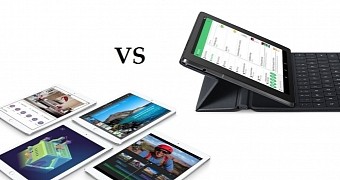In an earlier article today, we compared the aesthetic features and display capabilities of two of the hottest tablets on market today, the Nexus 9 and iPad Air 2. The devices are barely a few days old, so we are yet to know how they really behave in a real-life scenario.
Nevertheless, while we wait for the first batches to ship out to consumers, we will take a moment to do a spec shoot-up. This time we’ll target the performance and software department.
Performance
The Nexus 9 and iPad Air 2 have two very different chips on the inside but are both 64-bit platforms.
The Google tablet takes advantage of the NVIDIA Tegra K1 dual-core chipset based on a Denver CPU clocked at 2.3GHz working with Kepler DX1 GPU with 192 shader cores.
The Nexus 9’s preliminary benchmarking scores were posted and the Tegra K1 CPU was showed to be towering the completion, surpassing the A8 processor in the iPhone 6 / iPhone 6 Plus (the iPad Air 2 wasn't out yet, so the tests did not include it).
In the Apple camp, the iPad Air 2 has a dual-core A8X chipset clocked at 1.4GHz on the inside, which is based on ARMv8 architecture.
This is said to be an improved version of the 64-bit A8 chip found in the iPhone 6, so it should be interesting to see how the Nexus 9 CPU performs against the architecture found in the iPad Air 2.
In the memory department, the two tablets offer quite similar stories. But while the Nexus 9 adds 2GB of RAM onboard, the iPad Air 2 relies on just 1GB of RAM, which is a little disappointing for a flagship model. However, Apple fans might argue the highly optimized iOS doesn't need more.
Software and Interface
The battle between Android and iOS has been going on forever and is a never-ending debate. However, Android 5.0 Lollipop and its Material Design flavor are certainly something else.
The OS brings multiple improvements including system and battery life optimization, new notifications features, but most importantly a more intuitive and seamless way to navigate throughout the myriad of possibilities offered by the tablet.
Google is also putting an emphasis on productivity with the Nexus 9. That’s why it is offering the tablet with accessories such as a magnetic keyboard, which will help you get the job done when you need it.
The iPad Air 2 also takes advantage of the latest software, touting the recently launched iOS 8 platform. The tablet will get the new iOS 8.1 update, which should bring back the camera roll and the iCloud photo library.
Apart from that, one can’t help but notice that the differences between iOS and Android are starting to blur more and more and somehow both OS-es have sort of grown on top of each other, being influenced by the presence of the other.
Pricing and Impressions
So far, the Nexus tablet lineup has been known to be the bearer of good-specs and affordable price-tags. Well, the Nexus 9 turns out to be the most expensive so far. The tablet will be marketed in three models including with 16GB for $399 / €312, with 32GB for $479 / €375 and 32GB with LTE for $599 / €468.
A disadvantage here is that Google doesn't offer too much in terms of internal storage, a fact that might not agree with lots of users. On the other hand, the tablet comes with a really powerful chip, sports an optimal form-factor and looks really premium.
As for the iPad Air 2, things get a little more expensive. The 16GB Wi-Fi model sells for $499 / € 389 while the 16GB Wi-Fi model with cellular will set customers back with a hefty $629 / €491. Note that Apple offers 64GB or 128GB storage options, as well.
The battle between the two tablets is quite intense, and in the end it all boils down to preferences (and funds at your disposal). However, it appears to us the Nexus 9 manages to leverage productivity, looks and pricing better than the iPad Air 2.
Also check out our comparison between the Nexus 9 and iPad 2 in the Display and Design department.

 14 DAY TRIAL //
14 DAY TRIAL //